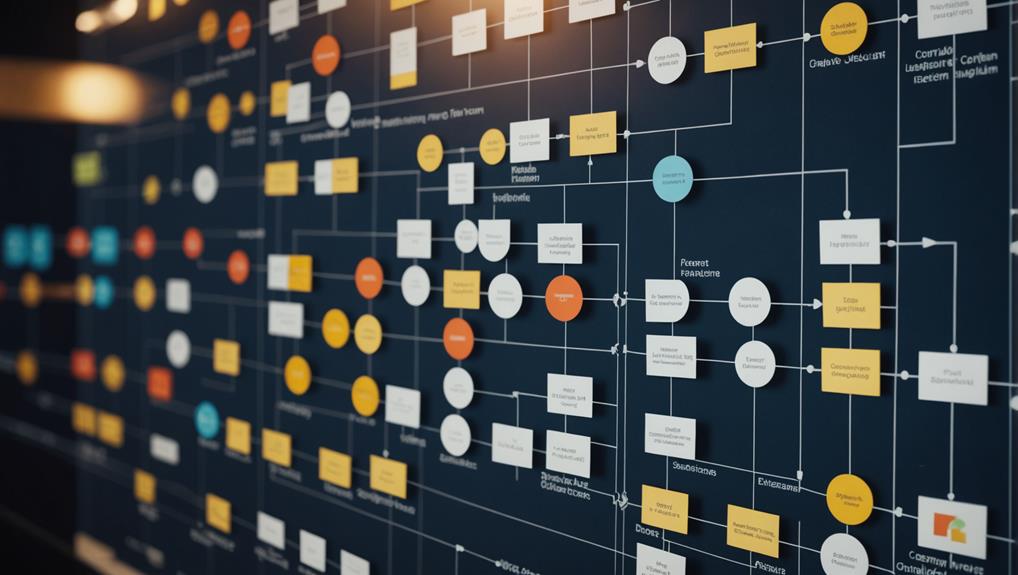Organizational Design Strategies for Streamlining Post-Merger Operations

When merging companies, it's crucial to align organizational structures to streamline operations and boost efficiency. Clearly defining decision-making authority reduces confusion and speeds up processes.
Identifying and resolving redundancies helps cut down on waste and optimizes resource utilization. Effective leadership and open communication are key to managing resistance and fostering a cohesive culture post-merger.
Incorporating technological solutions can improve productivity, while establishing clear roles and engaging employees solidify the new organizational framework.
By carefully planning and monitoring progress, the integration can progress smoothly in line with strategic objectives and maximize the merger's value. Successful navigation of these complexities requires targeted strategies that address these critical areas.
Key Takeaways
- Optimize organizational structures to enhance workflows and decision-making processes post-merger.
- Identify and remove redundancies to streamline operations and boost productivity.
- Standardize operational procedures to ensure uniformity and efficiency across integrated entities.
- Implement technology solutions to automate repetitive tasks and consolidate software platforms.
- Define clear roles and responsibilities to minimize duplication of efforts and enhance accountability.
Understanding Organizational Design
Organizational design in a merger is all about structuring processes, roles, and systems to ensure the new entity operates efficiently and makes effective decisions. Post-merger integration focuses on blending different organizational components into a cohesive whole. This meticulous approach involves defining structure, aligning processes, setting up reward systems, and establishing clear decision rights.
Creating an effective organizational design during a merger or acquisition involves integrating these components to form a streamlined operation. It's crucial to ensure that information flows smoothly within the new entity and that everyone understands their roles and responsibilities. This clarity reduces ambiguity and promotes a more productive environment.
Nevertheless, achieving seamless integration poses challenges. Cultural differences, leadership roles, and resistance to change can complicate the process. Strong leadership is essential in navigating these complexities with confidence and clarity.
Conflicting values and traditions among merging organizations often lead to employee resistance. Addressing these issues directly through thoughtful organizational design can pave the way for a successful merger, enabling smoother operations and improved operational efficiency.
Importance of Aligning Structures
Aligning organizational structures post-merger is crucial for optimizing workflow and decision-making processes. Evaluating and streamlining our organizational design ensures that roles, reporting lines, and decision-making authority are clearly defined. This alignment isn't just a task to check off after a merger; it's a strategic imperative that drives innovation and operational excellence.
When structures are aligned, it facilitates efficient information flow, reduces duplication, and enhances overall operational efficiency. Clear decision rights enable teams to make quicker and more well-informed decisions by knowing who's accountable for each aspect.
This structured alignment goes beyond just efficiency; it fosters a unified culture that encourages collaboration and propels us towards success.
Furthermore, well-aligned structures result in improved resource allocation and substantial cost savings. Clarity on roles and reporting structures helps prevent resource wastage and allows us to concentrate on essential tasks.
This transparency also boosts employee engagement as individuals feel more connected to their roles and the organization's objectives.
Evaluating Company Frameworks

We need to thoroughly assess our company frameworks to ensure they align with our post-merger goals. This assessment involves a detailed examination of our organizational structures, processes, decision-making authority, and information dissemination. By doing so, we can ensure efficiency in our post-merger operations.
Our main focus should be on crucial elements such as incentive systems, leadership positions, and communication channels. These components must be carefully analyzed to confirm they support our new, unified direction. Organizational modifications are unavoidable, and addressing integration challenges head-on will facilitate this transition.
It is crucial to analyze the cultural disparities between the merging entities. We must pinpoint conflicting values, traditions, and operational practices that could impede seamless integration. This insight will enable us to establish a cohesive environment conducive to innovation.
Moreover, evaluating existing structures is vital for optimizing decision-making and workflow. We must identify areas where current processes may overlap or clash, ensuring our new framework is streamlined and efficient.
Identifying Redundancies
Identifying redundancies in a post-merger integration scenario involves assessing overlapping departments, evaluating workforce efficiency, and consolidating similar functions. By closely examining roles and processes, organizations can pinpoint areas where tasks, reporting structures, or systems are duplicated. This focused approach not only streamlines operations but also results in significant cost savings and increased productivity.
During the post-merger integration phase, it's crucial to analyze the organizational structure and design to ensure a seamless transition. By identifying and eliminating redundancies, companies can create a more efficient and agile workforce. This strategic approach not only enhances operational effectiveness but also fosters a culture of innovation and collaboration.
Assess Overlapping Departments
When looking to streamline operations post-merger, the initial focus should be on identifying overlapping departments by examining their functions, responsibilities, and reporting structures. This analysis allows us to pinpoint redundancies that may impede our efficiency and effectiveness. In the realm of mergers and acquisitions, it's crucial to concentrate on organizational design to prevent duplicating efforts or squandering resources.
To evaluate overlapping departments effectively, we need to follow these steps:
- Analyze Functions and Responsibilities: By scrutinizing the tasks and responsibilities of each department, we can uncover any unnecessary duplication of roles.
- Review Reporting Structures: Examining reporting hierarchies within these departments can reveal redundancies in the chain of command that may require streamlining.
- Evaluate Resource Allocation: Assessing the resources, such as personnel and budgets, utilized by each department is vital. Identifying duplicated resources in overlapping departments can lead to consolidation and cost savings.
- Impact on Productivity and Costs: Consider the overall effect of these overlapping departments on productivity and operational costs. Redundant departments can deplete resources and diminish organizational effectiveness.
Evaluate Workforce Efficiency
After assessing the overlap between departments, our focus now shifts to evaluating workforce efficiency by identifying redundancies. To streamline workforce efficiency effectively, we must carefully compare job descriptions, responsibilities, and skill sets across the merging organizations. This comparison will enable us to pinpoint redundant roles or functions that may no longer be necessary in our newly combined structure.
Our first step is to evaluate the overlap in job titles and responsibilities to eliminate duplicate positions and ensure that our workforce is optimized for maximum productivity. We'll gather feedback through interviews, surveys, and assessments from employees to highlight potential redundancies and areas that can be consolidated.
Subsequently, we'll analyze performance metrics, productivity levels, and output to identify roles that can be combined or eliminated without compromising operational efficiency. By utilizing organizational design software, we can visualize workforce structures, making it easier to identify redundancies and optimize staffing levels for our post-merger operations.
Consolidate Similar Functions
We must systematically identify and merge duplicate functions across both organizations to streamline our operations effectively. By analyzing job responsibilities and tasks, we can eliminate redundancies and enhance efficiency. Consolidating analogous functions is crucial for reducing overlap and refining our reporting structures.
Here's a structured approach to accomplishing this:
- Identify Duplicate Roles: Evaluate each department to pinpoint overlapping roles and responsibilities. This will help us understand where redundancies exist.
- Analyze Job Responsibilities: Examine the tasks and responsibilities of each role to determine which can be combined or removed. This ensures we maximize the potential of our workforce.
- Consolidate Departments: Merge similar departments or teams to reduce overlapping functions. This consolidation clarifies reporting lines and improves communication.
- Evaluate Processes: Assess duplicated processes to determine their necessity and effectiveness. Streamlining operations optimizes resources and decision-making pathways.
This strategic approach to consolidating similar functions won't only eliminate redundancies but also streamline our operations, making the post-merger organization more cohesive and efficient. Aligning job descriptions, workflows, and responsibilities sets the foundation for a unified, high-performing entity capable of driving innovation and growth.
Streamlining Workflows

To streamline workflows effectively after a merger, it's essential to establish uniform operational procedures throughout the combined entities and incorporate advanced technology solutions that enhance efficiency.
Standardizing processes helps to minimize variations and ensure uniformity, while integrating technology, such as automation tools, can eradicate manual tasks and amplify productivity.
Standardizing Operational Procedures
Standardizing operational procedures after a merger typically results in substantial efficiency improvements by eliminating duplications and optimizing task sequences. By concentrating on streamlining workflows, we can establish a more cohesive and effective organization. Standardization not only enhances efficiency but also enhances communication, reduces errors, and increases overall productivity.
To achieve these efficiency gains, we can follow these steps:
- Identify Repetitive Processes: It's essential to carefully examine each department to pinpoint overlapping tasks. By eliminating these redundancies, we can ensure that every action taken adds significant value.
- Optimize Task Order: Evaluating and rearranging tasks to guarantee that workflows are logical and efficient can help minimize delays and bottlenecks.
- Enhance Employee Training: With consistent procedures, training becomes more straightforward, reducing confusion and aligning everyone with the organizational objectives.
- Improve Communication: Standardized processes establish a common language and understanding throughout the organization, leading to clearer and more effective communication.
Integrating Technology Solutions
Expanding on the foundation of standardized operational procedures, integrating technology solutions can further streamline workflows and enhance overall efficiency during the post-merger integration process. The journey towards integration begins with automating repetitive tasks, allowing our team to prioritize strategic initiatives.
By adopting unified software platforms, we can encourage seamless collaboration and data sharing across the combined entities, breaking down barriers and fostering a more cohesive work environment.
Tailoring technology solutions to fit our new organizational structure is crucial for success. Customized systems ensure that our specific requirements are addressed, optimizing operational efficiency and improving decision-making processes.
The incorporation of AI technologies enables us to analyze extensive data sets, forecast trends, and pinpoint areas for enhancement, making our post-merger operations more adaptable and forward-looking.
Investing in cloud-based solutions offers a myriad of advantages. This approach supports remote work, guaranteeing that our teams can access essential data from any location, at any time. Such flexibility not only accommodates a dynamic workforce but also scales with our organization's growth.
Embracing these technological advancements positions us to navigate the complexities of post-merger integration confidently and accurately, ultimately propelling long-term success and innovation in our newly unified organization.
Optimizing Resource Allocation
Optimizing resource allocation post-merger involves identifying redundant resources and reallocating them to improve efficiency. The focus should be on resource optimization, streamlining operations, and ensuring adequate support for critical functions. By optimizing resources, we can reduce waste and enhance overall performance, making post-merger operations more effective.
Here are four key strategies to consider:
- Eliminate Redundant Roles: Identify overlapping positions and merge them to eliminate redundancies. This will free up valuable resources that can be redirected to areas in need.
- Strategically Align Teams: Ensure that each unit operates at peak efficiency by aligning teams strategically. Match skill sets with critical functions and foster collaboration across departments.
- Adjust Budget Allocation: Evaluate financial resources and reallocate budgets to prioritize essential operations. This ensures that critical functions receive adequate funding, leading to smoother transitions and improved performance.
- Harness Synergies: Utilize the strengths of both merged entities to create synergies. This can result in innovative solutions and increased productivity across the organization.
Defining Reporting Lines

When we define reporting lines after a merger, it's crucial to clarify leadership roles to establish strong communication channels and effectively integrate departmental structures.
This clarity is essential for aligning with our strategic objectives and ensuring smooth decision-making processes. Addressing these aspects proactively can help prevent confusion, minimize conflict, and improve overall efficiency in our post-merger operations.
Clarifying Leadership Roles
Establishing clear reporting lines post-merger is crucial for defining leadership roles and ensuring a smooth decision-making process. This clarity helps prevent overlaps in responsibilities and promotes efficiency in our new organizational structure.
To achieve this, we should first identify key leadership roles within the merged entity. By pinpointing essential positions, we can allocate responsibilities effectively and provide each department with a clear point of contact.
Next, it's important to define reporting lines clearly. Outlining who reports to whom reduces confusion and ambiguity, giving employees a direct pathway for their concerns and ideas.
Additionally, establishing streamlined decision-making processes is essential. Transparent processes allow leaders to make timely and informed decisions, ensuring that the right information and authority are considered.
Lastly, effective communication of changes is key. Informing all employees about the new reporting structures and leadership roles helps everyone understand their positions and responsibilities within the new framework. Clarity in communication is vital for a successful post-merger integration.
Establishing Communication Channels
Now that leadership roles are clearly defined, it's crucial to establish transparent reporting lines within the newly merged organization. These reporting structures play a vital role in reducing ambiguity, minimizing confusion, and enhancing accountability. When employees have a clear understanding of who they report to, they can align with their new roles and responsibilities, leading to a sense of direction and purpose.
Defined reporting lines also facilitate the flow of information, feedback processes, and escalation procedures. These elements are essential for effective decision-making and problem-solving within the organization. By promoting collaboration and transparency, clear communication channels ensure that everyone is on the same page with the organizational objectives.
Let's explore the emotional impact of establishing clear reporting lines:
| Benefits | Emotions Evoked |
|---|---|
| Reduced Confusion | Confidence and Security |
| Enhanced Accountability | Trust and Reliability |
| Effective Problem-Solving | Empowerment and Clarity |
Aligning reporting lines after a merger is not just about structure; it's about creating an environment that fosters innovation. Clear communication channels encourage a culture where ideas can flow freely, and decisions can be made swiftly, propelling the organization forward.
Integrating Departmental Structures
Establishing clear reporting lines within newly integrated departmental structures is crucial for creating a cohesive and efficient post-merger organization. This step enhances accountability and streamlines decision-making, leading to smoother operations.
A well-planned integration strategy helps us define reporting relationships, ensuring effective communication flow and eliminating confusion across merged departments.
To optimize our integration strategy, we must focus on key elements:
- Accountability: Clear reporting lines enhance accountability by defining responsibilities and reporting structures for each team member.
- Communication: Mapping reporting relationships facilitates seamless communication flow, reducing misunderstandings and promoting collaboration.
- Role clarity: Clearly defined structures minimize role ambiguity and duplication of efforts, enabling employees to concentrate on their core tasks.
- Operational effectiveness: Aligning reporting lines with expertise and responsibilities allows us to leverage our team's strengths, enhancing operational efficiency.
Clarifying Roles and Responsibilities
Clearly defining roles and responsibilities after a merger is crucial for avoiding confusion and enhancing efficiency in the newly formed organization. Assigning specific responsibilities helps prevent duplicated efforts and streamlines decision-making processes, leading to a more cohesive and productive work environment.
Detailed role definitions are key to aligning employees with the new organizational structure and overarching goals, promoting clarity and focus.
Establishing clear roles and responsibilities fosters effective communication and accountability within the merged entity. This clarity reduces ambiguity, enhances workflow, and promotes a sense of unity among team members.
When individuals understand their duties and how they contribute to the organization's objectives, it promotes adaptability and innovation within the merged company.
Defining roles also plays a vital role in ensuring employee satisfaction and retention post-merger. By aligning responsibilities with individuals' skills and interests, organizations can boost morale and productivity, safeguarding against potential disruptions during the integration process.
Focus on these foundational elements sets the stage for a seamless transition and long-term success. A well-defined organizational structure not only enhances efficiency but also nurtures an environment conducive to innovation and growth.
Managing Change Resistance

Following the clarification of roles and responsibilities, it's crucial to address the common resistance to change that emerges during the post-merger integration phase. Research indicates that a significant number of change initiatives falter, with 70% failing due to resistance.
Proactively managing this resistance is paramount to ensure a smooth transition. The implementation of effective Change Management strategies becomes imperative to alleviate resistance and cultivate a culture of acceptance and cooperation.
To effectively combat change resistance, attention should be directed towards the following key areas:
- Clear Communication: Transparent and consistent communication plays a vital role. Providing regular updates and fostering open dialogues can help diminish uncertainty and establish trust among employees.
- Employee Engagement: Involving employees in the change process enhances their commitment and diminishes resistance. Encouraging feedback and involving them in decision-making processes can make them feel valued and invested in the transition.
- Identifying Resistance Origins: It's essential to pinpoint the underlying reasons for resistance, such as concerns about job security or apprehensions about new roles. Addressing these root causes directly through targeted interventions is crucial.
- Providing Assistance: Offering support through training, guidance, and resources is essential to aid employees in adapting to the changes. This not only facilitates the transition but also enhances morale and engagement levels.
Aligning Systems and Processes
When aligning systems and processes after a merger, meticulous planning and coordination are crucial to seamlessly merge different operational procedures. The challenge lies in reconciling variations in software platforms, operational workflows, and communication channels. Creating a unified system that boosts efficiency and drives synergy is key. This involves not only merging IT infrastructures but also harmonizing work methods to ensure everyone is aligned.
The initial step in aligning these systems and processes should involve conducting a thorough audit of existing frameworks. By identifying redundancies and gaps, operations can be streamlined effectively. Once a clear understanding of the existing systems is obtained, a customized integration plan should be developed, prioritizing quick wins while keeping long-term goals in mind.
Monitoring and continuous improvement play a vital role. Defining key performance indicators (KPIs) and conducting regular reviews are essential to ensure that the aligned systems and processes remain effective. This proactive approach enables swift adaptation to any emerging issues, maintaining operational efficiency.
Enhancing Communication

Effective communication serves as the foundation of a successful post-merger integration, building trust and reducing uncertainty among employees. Prioritizing clear and transparent communication is essential to managing expectations and minimizing resistance to change. Timely and consistent communication is key to aligning operations seamlessly, ultimately enhancing overall efficiency.
To enhance communication effectively, consider implementing the following strategies:
- Establish Defined Communication Channels:
Set up structured channels to facilitate information flow and streamline decision-making processes. This clarity reduces confusion and ensures everyone is on the same page.
- Provide Regular Updates:
Consistency is crucial. Offer frequent updates on the integration process to keep employees informed and engaged. This approach reassures them that progress is underway and alleviates anxiety about the unknown.
- Encourage Open Dialogue:
Create an environment where feedback is encouraged and acted upon. This fosters transparency and empowers employees to share their concerns and ideas, promoting a sense of inclusivity.
- Ensure Consistent Messaging from Leadership:
Ensure that leaders from both organizations deliver a unified message. This alignment in communication reinforces trust and showcases a cohesive strategy moving forward.
Cultural Integration
After enhancing communication, the next crucial step is to focus on cultural integration to ensure the merged entity operates smoothly as a unified organization. Aligning values, beliefs, and behaviors is vital for creating a cohesive organizational culture that drives post-merger success.
When organizational cultures are harmonized, we observe higher levels of employee engagement, retention, and overall performance.
Challenges may arise during cultural integration due to differences in communication styles, work norms, and leadership approaches. Overcoming these challenges requires fostering open communication to bridge gaps and promote mutual understanding. Cross-cultural training programs can equip employees with the necessary tools to navigate and embrace diversity within the new organizational structure.
Engaging in shared experiences like team-building activities and collaborative projects can further solidify cultural integration. By investing in these strategies, we ensure that post-merger operations aren't only efficient but also resilient and innovative.
Embracing cultural integration enhances organizational synergy and long-term sustainability, paving the way for a future where our combined strengths lead to unparalleled success.
Talent Management

When managing talent after a merger, the primary focus should be on integrating diverse teams and retaining key personnel to ensure a seamless transition. Utilizing tools like contingent offers and attractive financial packages can help in keeping our top talent engaged and dedicated to the new organization. Furthermore, implementing a data-driven approach to foster diversity won't only create a more inclusive workforce but also enhance its overall effectiveness.
By strategically combining different talents and skills from both merging entities, the newly formed organization can capitalize on the strengths of each team and create a more robust and competitive workforce. This approach won't only drive innovation but also enable the organization to adapt to market changes more effectively.
It is crucial to prioritize communication and transparency throughout the post-merger integration process to alleviate any concerns or uncertainties among employees. Open dialogue and clear expectations can help in building trust and alignment within the newly merged teams, fostering a positive work environment and promoting collaboration.
Integrating Diverse Teams
Integrating teams with diverse backgrounds and skills post-merger requires a strategic approach to align talent and foster collaboration effectively. It's crucial to not just bring groups together but to create a cohesive unit that maximizes the strengths of each individual.
Here are some key steps to efficiently integrate diverse teams after a merger:
- Assessing Strengths and Weaknesses: Start by evaluating the capabilities of both teams to identify where key talent can excel and where skill gaps may exist.
- Implementing Cross-Functional Teams: Establishing cross-functional teams promotes knowledge sharing and innovation, enabling diverse teams to collaborate more productively.
- Building a Unified Culture: Developing a unified organizational culture helps blend different backgrounds and work styles, ensuring everyone is aligned with the same mission.
- Fostering Collaboration: Encouraging open communication and collaboration is essential for integrating diverse teams successfully. Regular team-building activities and joint projects can help achieve this goal.
Retaining Key Personnel
Focusing on building strong teams post-merger, it's crucial to prioritize retaining key personnel to ensure operational stability and the success of the integration process.
Preserving institutional knowledge and operational continuity is our primary objective. One effective method to encourage key employees to stay is by offering retention bonuses or equity incentives during this transitional phase.
Early identification of high-potential employees enables us to provide them with growth opportunities, ultimately improving retention rates.
Clear and open communication about the impact of the merger on employees and their roles is vital in reducing uncertainty and fostering trust within the workforce.
To showcase our dedication to key personnel, implementing comprehensive career development programs and succession plans is essential. These initiatives not only recognize their invaluable contributions but also groom them for future leadership positions within the newly merged entity.
Monitoring Progress
To ensure the effectiveness of our post-merger strategies, it's essential to establish clear Key Performance Indicators (KPIs) for continuous progress monitoring. Monitoring progress plays a crucial role in maintaining alignment with our merger objectives and maximizing the benefits of our organizational design. By defining KPIs, we can track our advancement, identify areas for improvement, and make necessary adjustments.
Our monitoring approach should encompass the following aspects:
- Assessing Efficiency: Evaluating the efficiency of our streamlined processes, decision-making structures, and information flows post-merger is paramount. This assessment helps us ensure that we're operating at peak performance levels.
- Tracking Synergies: It's vital to measure the realization of anticipated synergies resulting from the merger. This includes gauging financial gains, operational efficiencies, and enhanced market positioning.
- Employee Integration: Monitoring the integration of our workforce is critical. Tracking employee satisfaction, retention rates, and productivity levels is key to ensuring a seamless progression post-merger.
- Customer Impact: Evaluating customer feedback and engagement metrics is essential for understanding the merger's effect on our customer base. This analysis allows us to adapt strategies accordingly.
Regularly reviewing these KPIs enables us to maintain alignment with our goals, facilitating quick adaptation to emerging challenges and opportunities.
Continuous Improvement

To foster continuous improvement in our post-merger operations, it's crucial to establish precise benchmarks and consistently assess our organizational structure. This involves defining key performance indicators (KPIs) and performance metrics that are in line with our business processes and strategic objectives. This alignment is essential to ensure that our organizational design remains flexible and efficient.
An integral part of driving continuous improvement is the routine review and enhancement of our organizational design methodologies. By staying attentive to industry trends and insights, we can incorporate leading practices that optimize our post-merger integrations. Working closely with experienced consultants and tapping into the diverse knowledge within the SEI team can provide tailored solutions for ongoing enhancement.
Taking a structured approach to measuring the efficacy of our strategies is paramount. Below is a straightforward table outlining the key areas of focus:
| Focus Area | Key Actions |
|---|---|
| Benchmarks | Establish clear, quantifiable objectives |
| KPIs | Specify and monitor pertinent metrics |
| Review Strategies | Regularly evaluate and adapt |
| Industry Trends | Stay informed about new developments |
Frequently Asked Questions
What Are the 5 Approaches to Organizational Design?
In the realm of mergers and acquisitions post-merger integration, companies adopt five distinct organizational structures to navigate the complexities of combining two entities. These structures include functional alignment, divisional focus, matrix integration, network collaboration, and hybrid balance. Each structure plays a crucial role in streamlining processes, clarifying roles, and fostering innovation within the newly merged organization.
Functional alignment ensures role clarity by organizing departments based on specific functions such as marketing, finance, or operations. This structure helps employees understand their responsibilities and how they contribute to the overall goals of the organization.
Divisional focus allows the merged entity to concentrate on specific markets, products, or regions. By dividing the organization into units based on these factors, companies can streamline decision-making processes, adapt quickly to market changes, and drive growth in targeted areas.
Matrix integration offers flexibility by creating cross-functional teams that work on projects or initiatives. This structure encourages collaboration, knowledge sharing, and a multidisciplinary approach to problem-solving.
Network collaboration promotes innovation by connecting employees, partners, and stakeholders across the organization. This structure fosters creativity, idea generation, and the exchange of best practices to drive continuous improvement and competitive advantage.
Hybrid balance combines elements of the other structures to create a customized approach that fits the unique needs of the merged organization. By blending different organizational design elements, companies can achieve a harmonious balance between efficiency, adaptability, and innovation.
How to Integrate After a Merger?
To successfully integrate after a merger, it is crucial to focus on efficient change management, aligning organizational cultures, and ensuring a seamless transition of leadership. By approaching these aspects with creativity and strategic planning, we can facilitate a seamless integration process that promotes growth and stability for all parties involved.
Change management plays a pivotal role in post-merger integration by guiding employees through the transition and minimizing resistance to change. Implementing clear communication channels, providing adequate training, and soliciting feedback can help employees adapt to new structures and processes more effectively.
Culture alignment is another critical factor in merger integration as it sets the tone for collaboration and cooperation between teams from different organizations. Identifying common values, fostering a shared vision, and promoting inclusivity can help create a unified organizational culture that supports the overall integration process.
Furthermore, a smooth leadership handover is essential for maintaining continuity and driving the merged entity towards its strategic objectives. Ensuring that key leaders from both companies are actively involved in decision-making, establishing clear roles and responsibilities, and promoting a culture of transparency can facilitate a seamless transition of leadership post-merger.
What Is Post-Merger Reorganization?
Imagine a symphony coming together: post-merger reorganization harmonizes cultures, enacts leadership changes, and ensures the retention of top talent. This process streamlines operations and brings teams together to form a cohesive, cutting-edge entity that fulfills the strategic goals of the merger.
In essence, post-merger reorganization is like conducting an orchestra, where different instruments blend seamlessly to create a unified and powerful sound. It involves restructuring the organizational framework, optimizing resources, and fostering a shared vision among employees from both merging entities.
What Is an Effective Strategy During Merger and Acquisition?
An effective strategy for mergers and acquisitions involves aligning leadership, integrating cultures, and retaining top talent. This ensures a seamless transition, maximizes the combined entity's potential, and paves the way for long-term success.
Aligning leadership is crucial in setting the tone for the newly merged organization. By ensuring that leaders from both companies are on the same page and working towards common goals, the integration process becomes smoother and more efficient. This alignment also helps in maintaining employee morale and confidence during times of change.
Integrating cultures is another key aspect of a successful merger or acquisition. Companies often have unique cultures that can clash when brought together. By proactively addressing cultural differences and finding common ground, organizations can create a harmonious work environment where employees from both sides feel valued and included.
Retaining top talent is essential for the continued success of the merged entity. Losing key employees during a merger or acquisition can have a significant impact on productivity and innovation. By implementing strategies to retain top talent, such as offering competitive compensation packages and providing opportunities for growth and development, companies can ensure that their best employees stay on board and continue driving the business forward.
Conclusion
By aligning our organizational structures, evaluating our frameworks, and streamlining our workflows, we can pave the way for a smoother transition post-merger.
It's crucial to identify and eliminate redundancies, akin to lightening a ship to enhance speed and efficiency.
Cultural integration and effective talent management will serve as our guiding principles during this period of change.
Regularly monitoring our progress and committing to continuous improvement will ensure that we stay on track towards a successful and harmonious future.
Let's work together to navigate these complexities and steer our organization towards a cohesive and prosperous tomorrow.
